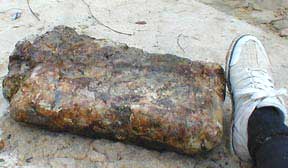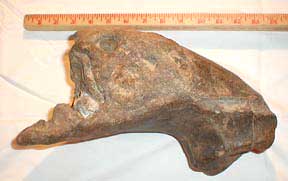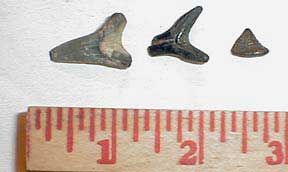Excerpts from Jim Conrad's
Naturalist Newsletter
from the February 9, 2003 Newsletter issued from the woods of the Loess Hill Region a few miles south of Natchez, Mississippi; elevation ~200ft (~60m), ~N31.42°, ~W91.41°; USA
FOSSILS FROM ST. CATHERINE CREEK
Last weekend Newsletter subscriber Karen Wise of Kingston, near Natchez, discovered a large, heavy, strange-looking item in the bed of St. Catherine Creek near her home. She sent a picture to me and we both thought it looked a lot like part of a petrified mastodon tusk. I forwarded the picture to my friend Earl Manning, who teaches paleontology at Tulane.
He decided that it wasn't a fossil at all, but rather "a large septarian concretion." This was a little disappointing, but still it was an amazing find, a real geological curiosity. That's Karen's concretion below:

Earl's willingness to look at photos encouraged Karen to send him more of things she'd found locally. She was especially interested in a large petrified jawbone with some teeth showing. This you can see that below.

Earl replied that this was the "left anterior part (including part of the symphysis) of the lower jaw of the mastodon Mammut americanum... It's likely derived from the Peoria Loess at Natchez, Adams Co., SW Miss., of Rancholabrean Land Mammal Age (probably about 15,000 yrs. old). Mastodon remains are fairly common along St. Catherine's Crk. They were browsing animals, living in the forests along the Mississippi River."
Then Karen sent photos of shark teeth she'd found in the same area. Earl actually seemed more excited about these than the mastodon jawbone. Shark teeth are commonly found up around Vicksburg, but not in the Natchez area. "I've never heard of any Vicksburg Group fossils washing all the way down to Natchez, and the equivalent-aged rock is deep below Natchez. Very interesting," he wrote.
He identified the shark producing Karen's teeth as a Sand Tiger Shark of the genus Odontaspis, often known as Carcharias. After conferring with David Dockery at the Mississippi Office of Geology in Jackson, they decided that a good guess was that Indians carried them here from the Vicksburg area. You can see some of Karen's tooth-finds below:

Karen also sent photos of other things she'd found and among Earl's identifications were Ice-Age White-tail Deer, American Alligator, Black Bear, Beaver and the extinct horse Equus complicatus. The latter reminds us that horses evolved in the Americas but went extinct soon after the Ice Age. Some specialists think they may have been hunted to extinction by the first Americans.
According to the Google search engine, one of the most popular spots on the Web to view fossil remains of Rancholabrean land mammals such as the above is my own page showing Lonnie Looper's fossils found on gravel bars in the Mississippi River near Greenville, at https://www.backyardnature.net/loess/fossils.htm